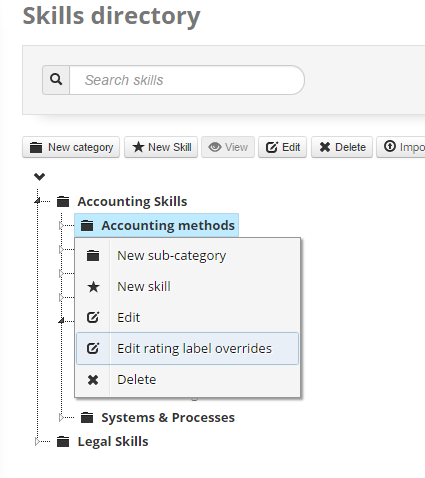Modifying the rating scheme
Feature availability: All licenses, except Free
Article applies to: Administrators only
Skills Base uses a numerical rating scheme for assessing skill and interest levels. By default, a 1 to 5 rating scheme is set, however you can change this in [Admin > Rating Scheme].
Skills Base allows from a two level (eg: 1 to 2, or 0 to 1) up to an eleven level (0 to 10) rating scheme for both skill and interest level (which can be configured independently). To add a rating, click "Add row". Likewise, to remove a rating click "Remove row". You can also customize the rating labels and descriptions. Rating labels are displayed during skill assessments as well as other parts of Skills Base.
The N/A and zero ratings
In addition to the 1-10 scale options, Skills Base provides two further ratings that can be enabled independently:
- The N/A rating allows people to effectively decline to rate a skill. It is useful to enable the N/A rating when you are more liberally assigning skills to people and some of those skills are not relevant to the person. N/A allows assessors the ability to flag the skill as "Not applicable". N/A is equivalent to no rating and as such does not have effect on average calculations throughout the system. For example, if a person self-assesses a skill at level 2, and their supervisor assesses it as N/A, the average will be 2.
- The zero rating allows people to rate skill and/or interest levels at level zero. This should be used to indicate "No skill" or "No interest" in a given skill. Zeros are always factored into average calculations, so a rating of zero will bring down the average skill or interest level. For example, if a person self-assesses a skill at level 2, and their supervisor assesses it at level 0, the average will be 1, calculated as 2 + 0 = 2 / 2 = 1
Data conversion
If you change the levels of the rating scheme when data already exists in the system, Skills Base will inform you that a data conversion is required.
Data conversion physically changes the responses that were given in assessments to make them conform to the new scheme. For example, if you originally had a 1-5 rating scheme and you changed that to a 1-4, wherever a response of "5" was given in an assessment it will be converted into a corresponding value in your new rating scheme (for example "4"). The exact mapping between the old scheme and the new one is specified by you, and you will be prompted to provide this before the data conversion has completed.
Precision loss when reducing the rating range
If you reduce the rating range, for example if you change from a 1 to 5 rating scheme to a 1 to 4 rating scheme, Skills Base will warn you about "precision loss". Precision loss means that there will be no way to distinguish between two or more specific ratings provided under the old scheme once the data conversion is executed.
For example, consider the following data conversion mapping for a 1-5 to 1-4 rating scheme conversion:
| Old scheme | New scheme | |
| 1 | -> | 1 |
| 2 | -> | 2 |
| 3 | -> | 3 |
| 4 | -> | 4 |
| 5 | -> | 4 |
As you can see above, all ratings of 5 will be converted to 4. The loss of precision comes from the fact that after the conversion has completed it will be no longer be possible to know whether a person rated themselves 4 or 5 under the old scheme. All that can be known after the conversion is that it is now a 4.
Precision loss is mainly an issue if you decide to go back to your old scheme after the data conversion had completed (in the above example going back to a 1-5 scheme). So consider carefully before converting your data and extract an export of your data in case it needs to be referenced in the future before proceeding as data conversions are not reversible!
Rating Label Overrides
You can override the labels and descriptions that you define in the master rating scheme on a per-category basis. That is, if you have a skill category that needs to have a different or specific set of labels and descriptions in order to give better meaning to the numeric rating scale in the context of the specific skill category, you can define unique labels and descriptions that will apply only to that specific skill category.
To add a rating label override, simple right click on the skill category in the Skills Directory and select "Edit rating label overrides"

